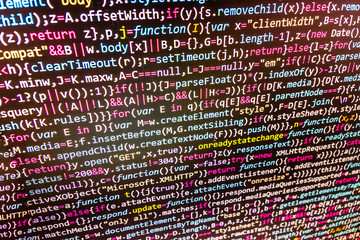
PUBLISHER'S NOTE: Artificial intelligence, once the stuff of science fiction, has become all to real in our modern society - especially in the American criminal justice system; As the ACLU's Lee Rowland puts it: "Today, artificial intelligence. It's everywhere — in our homes, in our cars, our offices, and of course online. So maybe it should come as no surprise that government decisions are also being outsourced to computer code. In one Pennsylvania county, for example, child and family services uses digital tools to assess the likelihood that a child is at risk of abuse. Los Angeles contracts with the data giant Palantir to engage in predictive policing, in which algorithms identify residents who might commit future crimes. Local police departments are buying Amazon's facial recognition tool, which can automatically identify people as they go about their lives in public." The algorithm is finding its place deeper and deeper in the nation's courtrooms on what used to be exclusive decisions of judges such as bail and even the sentence to be imposed. I am pleased to see that a dialogue has begun on the effect that increasing use of these logarithms in our criminal justice systems is having on our society and on the quality of decision-making inside courtrooms. As Lee Rowland asks about this brave new world, "What does all this mean for our civil liberties and how do we exercise oversight of an algorithm?" In view of the importance of these issues - and the increasing use of artificial intelligence by countries for surveillance of their citizens - it's time for yet another technology series on The Charles Smith Blog focusing on the impact of science on society and criminal justice. Up to now I have been identifying the appearance of these technologies. Now at last I can report on the realization that some of them may be two-edged swords - and on growing pushback.
Harold Levy: Publisher; The Charles Smith Blog:
------------------------------------------------------------
PASSAGE OF THE DAY: "Neuroprediction, as it has been dubbed, evokes uneasy memories of a time when phrenologists used body proportions to make pronouncements about a person’s intelligence, virtue, and — in its most extreme iteration — racial inferiority. Yet predicting likely human behavior based on algorithms is a fact of modern life, and not just in the criminal justice system. After all, what is Facebook if not an algorithm for calculating what we will like, what we will do, and who we are?
------------------------------------------------------------
PASSAGE TWO OF THE DAY: "Over the past two decades, brain scans and other neuroscientific evidence have become commonplace in courtrooms. So much so that a defendant can file an “ineffective assistance of counsel” claim if his or her lawyer fails to introduce relevant brain tests. And defense lawyers ordinarily submit brain imaging to bolster claims of their clients’ incompetency or insanity. Still some legal scholars and attorneys decry the growing presence of neuroscience in courtrooms, calling it a “double-edged sword” that either unduly exonerates defendants or marks them as irredeemable future dangers. “But that’s not right,” said Deborah Denno, a professor and director of the Neuroscience and Law Center at Fordham University Law School, who conducted an analysis of every criminal case that used neuroscientific evidence from 1992 to 2012. Her analysis showed that brain evidence is typically introduced to aid fact-finding with more “complete, reliable, and precise information.” She also showed that it is rarely used to support arguments of future dangerousness. To date, neuroprediction has not been admitted into the courtroom or parole hearings. Some scholars, like Thomas Nadelhoffer, a fellow at the Kenan Institute for Ethics at Duke University, who popularized the term neuroprediction, argue that the science is reliable enough to integrate with other risk assessments. The main obstacle, Nadelhoffer said, is reluctant defense attorneys who fear branding their clients as biologically predisposed toward crime. “Whereas I see it as a mitigating factor,” he said, a jury might not — reasoning that if the problem is in your brain, “Well, then we better lock you up.” Not all experts agree on the state of the art, however. “There is much research afoot, but the science of neuroprediction is not ready for prime time,” said Francis X. Shen, a senior fellow in law and neuroscience at the Harvard Center for Law, Brain, and Behavior."
--------------------------------------------------------------
STORY: "A Dangerous Brain: Can neuroscience predict how likely someone is to commit another crime?", by reporter Andrew R. Calderon, published by The Marshall Project. (Andrew R. Calderon is a data reporting fellow at The Marshall Project. A graduate of the Columbia School of Journalism, he uses programming and data analysis tools to report on the intersection of the environment, science, and the criminal justice system. Justice Lab is a column that examines the science, social science and technology of criminal justice.)
PHOTO CAPTION: "Scans showing parts of the brain with gray matter volume highlighted. In the study, the researchers confirmed that younger brains have reduced gray matter volume, which scientists think increases the probability of antisocial behavior."
Still some legal scholars and attorneys decry the growing presence of neuroscience in courtrooms, calling it a “double-edged sword” that either unduly exonerates defendants or marks them as irredeemable future dangers. “But that’s not right,” said Deborah Denno, a professor and director of the Neuroscience and Law Center at Fordham University Law School, who conducted an analysis of every criminal case that used neuroscientific evidence from 1992 to 2012. Her analysis showed that brain evidence is typically introduced to aid fact-finding with more “complete, reliable, and precise information.” She also showed that it is rarely used to support arguments of future dangerousness.
To date, neuroprediction has not been admitted into the courtroom or parole hearings. Some scholars, like Thomas Nadelhoffer, a fellow at the Kenan Institute for Ethics at Duke University, who popularized the term neuroprediction, argue that the science is reliable enough to integrate with other risk assessments. The main obstacle, Nadelhoffer said, is reluctant defense attorneys who fear branding their clients as biologically predisposed toward crime. “Whereas I see it as a mitigating factor,” he said, a jury might not — reasoning that if the problem is in your brain, “Well, then we better lock you up.” Not all experts agree on the state of the art, however. “There is much research afoot, but the science of neuroprediction is not ready for prime time,” said Francis X. Shen, a senior fellow in law and neuroscience at the Harvard Center for Law, Brain, and Behavior. He said that the current predictive value of biological indicators is overstated. Even if neuroprediction were accurate enough to be accepted in a courtroom, some question whether judges are properly trained to interpret scientific and statistical evidence. Judge Morris Hoffman, who sits in Colorado’s 2nd Judicial District and was among the first members of the MacArthur Foundation Research Network on Law & Neuroscience, says that tools like neuroprediction could be a “hazard” in the hands of untrained judges. “We judges can become over-reliant on statistical tools because they are shiny and new,” he said. Federica Coppola, a presidential scholar in society and neuroscience at Columbia University, contends that neuropredictions of future behavior could pose a threat to civil liberties and privacy.
Coppola proposes using a defendant’s brain profile not to mete out punishment, but rather to design alternative sentences based on social and emotional training. “Especially for young offenders, we can encourage growth in brain areas linked to skills like empathy or self-control,” she writes. Possibly increasing their chances of staying out of prison."

PUBLISHER'S NOTE: I am monitoring this case/issue. Keep your eye on the Charles Smith Blog for reports on developments. The Toronto Star, my previous employer for more than twenty incredible years, has put considerable effort into exposing the harm caused by Dr. Charles Smith and his protectors - and into pushing for reform of Ontario's forensic pediatric pathology system. The Star has a "topic" section which focuses on recent stories related to Dr. Charles Smith. It can be found at: http://www.thestar.com/topic/
Harold Levy: Publisher; The Charles Smith Blog;
---------------------------------------------------------------------
